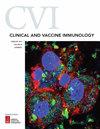在高度接种人群中流行性腮腺炎暴发诊断测试结果解释的挑战
Q2 Biochemistry, Genetics and Molecular Biology
引用次数: 15
摘要
尽管由于疫苗接种大大降低了发病率,但在世界上的一些地区,有时在接种疫苗的人群中,腮腺炎的爆发仍在继续发生。本文描述了加拿大安大略省西南部高度接种疫苗人群中的一次暴发,以及在解释暴发中使用的诊断测试结果时遇到的挑战。在疫情期间,对患者进行了访谈,并根据疫情病例定义对患者进行分类,并根据安大略省指南收集标本进行诊断检测。根据病例定义,27例为确诊病例(n = 19)或疑似病例(n = 8),其中实验室确诊病例9例,逆转录酶PCR (RT-PCR)确诊7例,IgM血清学确诊2例。所有19例确诊病例均为与当地中学有关的患者,并接种了一剂(n = 2)或两剂(n = 17)麻疹-腮腺炎-风疹(MMR)疫苗。这是安大略省首次发表的腮腺炎暴发报告,其中所有确诊病例都接种了该疾病的疫苗。它强调了目前用于接种疫苗个体的腮腺炎诊断检测的局限性和解释困难。本文章由计算机程序翻译,如有差异,请以英文原文为准。
Challenges in Interpretation of Diagnostic Test Results in a Mumps Outbreak in a Highly Vaccinated Population
ABSTRACT In spite of a greatly reduced incidence rate due to vaccination, mumps outbreaks continue to occur in several areas of the world, sometimes in vaccinated populations. This article describes an outbreak in a highly vaccinated population in southwestern Ontario, Canada, and the challenges encountered in interpreting the results of diagnostic tests used in the outbreak. During the outbreak, patients were interviewed and classified according to the outbreak case definition, and specimens were collected for diagnostic testing according to Ontario guidelines. Twenty-seven individuals were classified as confirmed cases (n = 19) or suspect cases (n = 8) according to the case definition, only 9 of which were laboratory-confirmed cases: 7 confirmed by reverse transcriptase PCR (RT-PCR) and 2 by IgM serology. All 19 confirmed cases represented patients who were associated with secondary schools in the local area and had been vaccinated against mumps with one (n = 2) or two (n = 17) doses of the measles-mumps-rubella (MMR) vaccine. This is the first published report of an outbreak of mumps in Ontario in which all confirmed cases had been vaccinated against the disease. It highlights the limitations of and difficulties in interpreting current mumps diagnostic tests when used in vaccinated individuals.
求助全文
通过发布文献求助,成功后即可免费获取论文全文。
去求助
来源期刊

Clinical and Vaccine Immunology
医学-传染病学
CiteScore
2.88
自引率
0.00%
发文量
0
审稿时长
1.5 months
期刊介绍:
Cessation. First launched as Clinical and Diagnostic Laboratory Immunology (CDLI) in 1994, CVI published articles that enhanced the understanding of the immune response in health and disease and after vaccination by showcasing discoveries in clinical, laboratory, and vaccine immunology. CVI was committed to advancing all aspects of vaccine research and immunization, including discovery of new vaccine antigens and vaccine design, development and evaluation of vaccines in animal models and in humans, characterization of immune responses and mechanisms of vaccine action, controlled challenge studies to assess vaccine efficacy, study of vaccine vectors, adjuvants, and immunomodulators, immune correlates of protection, and clinical trials.
 求助内容:
求助内容: 应助结果提醒方式:
应助结果提醒方式:


